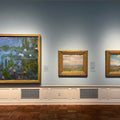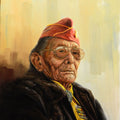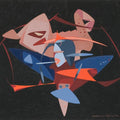Julia Arriola debuts new series of ledger drawings focusing on pow wows and fairs
By Medicine Man Gallery on
The Ledger Drawings of Julia Arriola
Walking into an antique shop in Fredricksburg, TX, Tucson native Julia Arriola (b. 1952; Mescalero/Mayo) didn’t expect to walk out as a ledger artist. She didn’t. That would come later, following her 20-year career as a curator at the Arizona Historical Society.
What she did walk out of that shop with, however, was an 1869 ledger book dug out of a storage room and acquired for $10 which would ultimately send her down the path of ledger drawing. Names and numbers. Things bought and sold. Mostly by men although a few by women as well – what stories they must have. Where the ledger originated from, unknown.
“I got chills when I first saw it,” Arriola remembers. “I had no idea what I was going to use it for. It was not in my head to make ledger drawings. I just bought it and came back to Tucson and left it there for a while.”
Arriola knew ledger artists, but didn’t pick up the practice herself until just prior to the pandemic. Her latest drawings will be on view and for sale at Medicine Man Gallery in Tucson beginning April 22nd in a solo show titled “Pow Wows and Fairs.” Arriola will be at the gallery to visit with collectors Friday, April 22 and Saturday, April 23 from 12:00 until 2:00 PM.
With pow wows and Native American fairs canceled due to COVID-19 the past two years and now returning, Arriola, who’s always enjoyed attending them, felt they were a fitting subject for her work.
“When (pow wows) first started, it was sacred, but what it’s evolved to now is social,” Arriola explains. “There are some spiritual aspects in it, but a lot of it is social.”
For the Southwestern tribes Arriola is most familiar with, many have incorporated pow wows into their annual tribal fairs combining carnival midway rides and games, concerts, dancing and even rodeo with traditional harvest festival.
“Pow Wows are the Native American people’s way of meeting together, to join in dancing, singing, visiting, renewing old friendships, and making new ones. This is a time (honored) method to renew Native American culture and preserve the rich heritage of American Indians,” according to Powwow.com which also features a listing of upcoming pow wows by state. Yes, non-Native people are welcome to attend.
The pow wows and fairs Arriola depicts are populated by creatures and figures from Native American myths and stories: coyote, badger, bear, crow, mudhead, Koshari. All are outfitted with Steampunk-era accoutrements like machinery, gears and goggles to accent their natty period dress.
“I am so familiar with these creatures now that they almost dress themselves,” she said.
Arriola has long been fascinated by the Steampunk aesthetic, a subgenre of science fiction dealing with 19th-century societies in the midst industrial revolution and its steam-powered technology. She also recognizes this era was a particularly tragic one for Native Americans steamrolled by the “overwhelming force of Manifest Destiny,” as she describes it.
Native tribes and nations suffered universally during this period, so multiple traditions come together in Arriola’s imagined pow wow and fair scenes.
Her pan-Indian approach is also owed in part to coming to her own Native heritage later in life, and largely on her own. Both of her parents – father, Mescalero Apache, and mother, Mayo – were totally separated from their Indigenous cultural roots.
“When he’d been drinking a while, he’d let things come out. I would find out things that way and then I’d ask him to clarify when he was his normal self and he’d get mad or say, ‘stop living in the past,’” Arriola recalls. “If I wasn’t going to get it from him, I was going to go look for it myself, and I did.”
That wouldn’t occur until her 30s, after going through rehab for her own problems with alcohol and drug addiction.
“When I cleaned up and got to know more of myself, that’s when I started seeing what’s going on and started asking my dad questions,” Arriola said.
For her father, an Air Force lifer and master sergeant, these were not conversations he wanted to take partake in. He experienced combat in Korea, prejudices faced for being Native American in the country he would commit his life in service to, alcoholism, poverty – Arriola recalls years passing between brief talks she spurred with her father attempting to encourage him to share memories of his background.
Mostly fruitless efforts.
Maybe he attended an Indian Boarding School to add to the other traumas life threw his way, maybe not.
“Nobody would talk about it, whenever something like that came up, everybody got quiet,” Arriola remembers. “I think they represented themselves more Mexican in order to not have to experience boarding schools. I don’t have the absolute proof and I never will.”
Among close family, only Arriola’s mother’s mother was connected to her Indigenous culture, but that grandmother died when the artist was 11. Then puberty hit, experimenting with drugs and alcohol, odd jobs, enrolling in the Navy – revenge at her father who wanted her to serve in the Air Force – more odd jobs and rehab in her late 20s.
She eventually found her way to art classes at Pima Community College in Tucson, including blacksmithing. These she enjoyed like nothing else previously in her life. She would go on to earn her bachelor and masters of fine art degrees in Sculpture and Metals at the University of Arizona, as well as a masters in Landscape Architecture.
“I didn’t start the drawings until I was retired and I had no idea anything like that was going to happen,” Arriola said.
She remembers her mom telling her that all she wanted to do as a child was draw, but that was let go during her rambunctious teenage years.
The depths of Arriola’s turbulent life lie just beneath the surface of her pow wow and fair drawings. Something ominous, if unseen, backgrounding the gaiety. Dancing, cotton candy, rides, but disturbing in a way.
Small sheets of paper, just over 10 x 14 inches, with so much to say.
Listen to Juila Arriola discuss her life and ledger drawings on this episode of Mark Sublette’s “Art Dealer Diaries” podcast:




